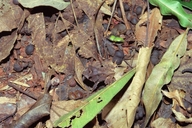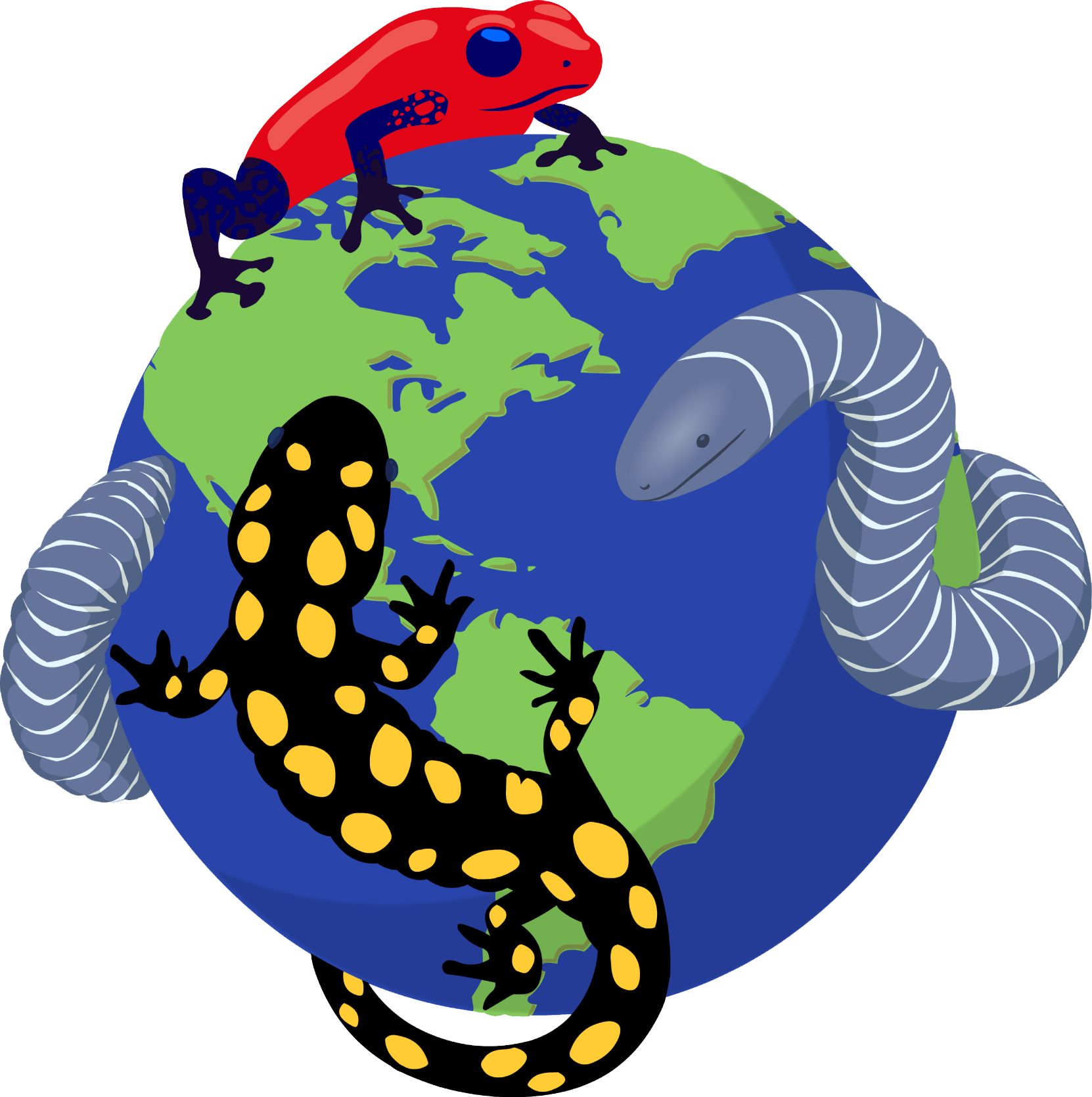|
Description
Proceratophrys melanopogon is a medium-sized frog (SVL 34.9-49.9 mm in males and 40.7-62.1 mm in females; Prado and Pombal 2008), which is closely related to P. appendiculata (Amaro et al. 2009), to which it was until recently considered a synonym (Heyer et al. 1990). The snout is rounded, tips of fingers slightly to noticeably swollen, not disked; fingers without webbing or fringes, sides of fingers smooth or with slight ridges; basal finger subarticular tubercles moderately well developed, distal tubercles less well developed, single; well-developed supratympanic fold, sides of body areolate with glandular warts; dorsal texture smooth or finely granular with scattered warty tubercles; irregular dark blotches. one from between eyes to past shoulders, second just past sacrum to coalesced into one large oblong blotch (Heyer et al. 1990; Prado and Pombal 2008). Izecksohn et al. (2005) and Prado and Pombal (2008) described the osteology. Prado and Pombal (2008) also re-described the holotype and presented several details about phenetic relationships and type specimens.
Distribution and Habitat
Country distribution from AmphibiaWeb's database: Brazil
Proceratophrys melanopogon occurs in areas of Atlantic forest in eastern Minas Gerais, Rio de Janeiro, and southeastern São Paulo in southeastern Brazil at elevations ranging from 800 – 1,480 m asl. It inhabits leaf litter and breeds in forest streams and rivulets inside primary forests. Life History, Abundance, Activity, and Special Behaviors
This species is an explosive breeder, with calling males forming agglomerations with up to 30 individuals at night, after heavy rains. Males call from small concavities on stream banks during the rainy season, between September and May (Heyer et al. 1990). Calling activity begins usually at 1800 h and ends by midnight (Mangia et al. 2010; Provete et al. 2013). Adults and tadpoles occur only in slow-flowing, forested streams. Tadpoles of P. melanopogon inhabit narrow (60–80 cm wide) temporary and permanent streams, between October and February, specifically in stream pools with clay, coarse or fine sand, and fine gravel on the bottom (Provete et al. 2013).
The advertisement call consists of a multipulsed (12‑41 pulses) note with a mean duration of 0.39 s, emitted sporadically, and a dominant frequency around 1179 Hz. (Mângia et al. 2010).
There is a report of defensive behavior, in which one specimen flattened its body and stretched out its legs (Moura et al. 2010).
Larva
The tadpole's body is ovoid in dorsal view, and slightly depressed in lateral view. The eyes are dorsal and oriented dorsolaterally. The nares are oval with a small marginal rim, dorsally positioned, located closer to the eyes than the tip of the snout, directed upward. A single sinistral spiracle, directed posterodorsally, with inner wall present as a slight ridge. The vent tube is short, dextral, with right wall displaced dorsally. The dorsal fin originates at the body–tail junction and is widely arched and higher than the ventral fin. The oral disc is ventral, and laterally emarginated. The marginal papillae are conical, disposed in a single row laterally, alternated posteriorly, with a wide anterior gap, which is slightly shorter than A-1. LTRF 2(2)/3(1). Anterior jaw sheath widely arched, posterior jaw sheath V-shaped and curved inward. In formalin, the body wall is transparent in dorsal view, with small, scattered light-gray melanophores along the body. Broad transverse stripes on the caudal musculature in dorsal view (Provete et al. 2013). Provete et al. (2013) thoroughly described the larval internal oral features of this species and compared it with P. moratoi and P. cururu. Trends and Threats
This species seems to be very abundant, but not very common, since it only calls and breeds after heavy rains and in specific habitats, such as narrow streams inside primary forests. It occurs in several Protected Areas throughout its range in southeastern Brazil, such as Serra da Bocaina National Park (Provete et al. 2013; Garey et al. in review), Boracéia Biological station (Heyer et al. 1990), Campos do Jordão State Park, Serra do Mar State Park (Mângia et al. 2010), and Bananal Ecological Station (Zaher et al. 2005) in São Paulo, Ibitipoca State Park, Serra do Brigadeiro State Park (Prado and Pombal 2008) in Minas Gerais, Três Picos State Park (Siqueira et al. 2011a), Itatiaia National Park (Prado and Pombal 2008) and Desengano State Park (Siqueira et al. 2011b) in Rio de Janeiro. Possible reasons for amphibian decline General habitat alteration and loss
Habitat modification from deforestation, or logging related activities
Intensified agriculture or grazing
Secondary succession
Subtle changes to necessary specialized habitat
Habitat fragmentation
References
Amaro, R. C., Pavan, D., and Rodrigues, M. T. (2009). ''On the generic identity of Odontophrynus moratoi Jim & Caramaschi, 1980 (Anura, Cycloramphidae) .'' Zootaxa, 2071, 61-68.
Heyer, W. R., Rand, A. S., Cruz, C. A. G., Peixoto, O. L., and Nelson, C. E. (1990). ''Frogs of Boracéia.'' Arquivos de Zoologia Sao Paulo, 31, 231-410.
Izecksohn, E., Carvalho-e-Silva, S. P. and Deiss, I. (2005). ''O osteocrânio de Proceratophrys boiei (Wied-Neuwied), P. appendiculata (Günther), P. melanopogon (Miranda-Ribeiro) e P. laticeps Izecksohn & Peixoto (Anura, Leptodactylidae).'' Revista Brasileira de Zoologia, 22, 225–229.
Izecksohn, E., and Peixoto, O.L. (1981). ''Nova espécie de Proceratophrys da hiléia Bahiana, Brasil (Amphibia, Anura, Leptodactylidae).'' Brazilian Journal of Biology, 41, 19–24.
Moura, M. R., Santana, D.J., Mangia, S., and Feio, R.N. (2010). ''Proceratophrys melanopogon (Black-bearded Horned Leaf Toad). Defensive behavior.'' Herpetology review, 41(4), 479.
Mângia, S., Santana, D.J. & Feio, R.N. (2010). ''Advertisement call of the Cycloramphid Toad Proceratophrys melanopogon (Miranda-Ribeiro, 1926).'' South American Journal of Herpetology, 5, 127–131.
Prado, G. M., and Pombal, J. P. (2008). ''Espécies de Proceratophrys Miranda-Ribeiro, 1920 com apêndices palpebrais (Anura; Cycloramphidae).'' Arquivos de Zoologia, 39, 1-85.
Provete, D. B., Melo, L. S. O., Garey,M. V., Gomes, F. B. R., Martins, I. A., and Rossa-Feres, D. C. (2013). ''Larvae of Proceratophrys melanopogon (Amphibia: Anura), with Emphasis on Internal Oral Morphology and Comparisons with P. Cururu and P. Moratoi.'' Herpetologica,, 69(2), 163-174.
Siqueira, C. C. et al. (2011). ''Anurans from two high-elevation areas of Atlantic Forest in the state of Rio de Janeiro, Brazil.'' Zoologia, 28(4 ), 457-464.
Zaher, H., Aguiar, E., and Pombal JR., J. P. (2005). ''Paratelmatobius gaigeae (Cochran, 1938) re-discovered (Amphibia, Anura, Leptodactylidae).'' Arquivos do Museu Nacional, 62(2), 321-328.
Originally submitted by: Diogo B. Provete (first posted 2013-12-07)
Edited by: Michelle S. Koo (2022-08-15)Species Account Citation: AmphibiaWeb 2022 Proceratophrys melanopogon: Horned Frog <https://amphibiaweb.org/species/6013> University of California, Berkeley, CA, USA. Accessed Apr 20, 2024.
Feedback or comments about this page.
Citation: AmphibiaWeb. 2024. <https://amphibiaweb.org> University of California, Berkeley, CA, USA. Accessed 20 Apr 2024.
AmphibiaWeb's policy on data use.
|




 Map of Life
Map of Life